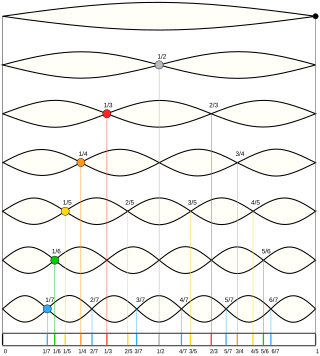Breathy voice is a phonation in which the vocal folds vibrate, as they do in normal (modal) voicing, but are adjusted to let more air escape which produces a sighing-like sound. A simple breathy phonation,, can sometimes be heard as an allophone of English between vowels, such as in the word behind, for some speakers.

A harmonic series is the sequence of harmonics, musical tones, or pure tones whose frequency is an integer multiple of a fundamental frequency.
In music performance and notation, legato indicates that musical notes are played or sung smoothly and connected. That is, the player makes a transition from note to note with no intervening silence. Legato technique is required for slurred performance, but unlike slurring, legato does not forbid re-articulation.

The human voice consists of sound made by a human being using the vocal tract, including talking, singing, laughing, crying, screaming, shouting, humming or yelling. The human voice frequency is specifically a part of human sound production in which the vocal folds are the primary sound source.

In physics, acoustics, and telecommunications, a harmonic is a sinusoidal wave with a frequency that is a positive integer multiple of the fundamental frequency of a periodic signal. The fundamental frequency is also called the 1st harmonic; the other harmonics are known as higher harmonics. As all harmonics are periodic at the fundamental frequency, the sum of harmonics is also periodic at that frequency. The set of harmonics forms a harmonic series.

An overtone is any resonant frequency above the fundamental frequency of a sound. In other words, overtones are all pitches higher than the lowest pitch within an individual sound; the fundamental is the lowest pitch. While the fundamental is usually heard most prominently, overtones are actually present in any pitch except a true sine wave. The relative volume or amplitude of various overtone partials is one of the key identifying features of timbre, or the individual characteristic of a sound.

In musical instrument classification, string instruments or chordophones, are musical instruments that produce sound from vibrating strings when a performer plays or sounds the strings in some manner.
Vibrato is a musical effect consisting of a regular, pulsating change of pitch. It is used to add expression to vocal and instrumental music. Vibrato is typically characterized in terms of two factors: the amount of pitch variation and the speed with which the pitch is varied.

Singing is the act of creating musical sounds with the voice. A person whose profession is singing is called a singer, artist or vocalist. Singers perform music that can be sung with or without accompaniment by musical instruments. Singing is often done in an ensemble of musicians, such as a choir. Singers may perform as soloists or accompanied by anything from a single instrument up to a symphony orchestra or big band. Different singing styles include art music such as opera and Chinese opera, Indian music, Greek music, Japanese music, and religious music styles such as gospel, traditional music styles, world music, jazz, blues, ghazal, and popular music styles such as pop, rock, and electronic dance music.
Falsetto is the vocal register occupying the frequency range just above the modal voice register and overlapping with it by approximately one octave.
Belting is a specific technique of singing by which a singer carries their chest voice above their break or passaggio with a proportion of head voice. Belting is sometimes described as "high chest voice" or "mixed voice", although if this is done incorrectly, it can potentially be damaging for the voice. It is often described as a vocal register, although this is also technically incorrect; it is rather a descriptive term for the use of a register.
Bel canto —with several similar constructions —is a term with several meanings that relate to Italian singing.
Chorus is an audio effect that occurs when individual sounds with approximately the same time, and very similar pitches, converge. While similar sounds coming from multiple sources can occur naturally, as in the case of a choir or string orchestra, it can also be simulated using an electronic effects unit or signal processing device.
A nut, on a stringed musical instrument, is a small piece of hard material that supports the strings at the end closest to the headstock or scroll. The nut marks one end of the vibrating length of each open string, sets the spacing of the strings across the neck, and usually holds the strings at the proper height from the fingerboard. Along with the bridge, the nut defines the scale lengths of the open strings.
Throat singing refers to several vocal practices found in different cultures worldwide. The most distinctive feature of such vocal practices is to be associated to some type of guttural voice that contrasts with the most common types of voices employed in singing, which are usually represented by chest (modal) and head registers. Throat singing is often described as producing the sensation of more than one pitch at a time, i.e., the listener perceives two or more distinct musical notes while the singer is producing a single vocalisation.

Violin acoustics is an area of study within musical acoustics concerned with how the sound of a violin is created as the result of interactions between its many parts. These acoustic qualities are similar to those of other members of the violin family, such as the viola.
Vocal resonance may be defined as "the process by which the basic product of phonation is enhanced in timbre and/or intensity by the air-filled cavities through which it passes on its way to the outside air." Throughout the vocal literature, various terms related to resonation are used, including: amplification, filtering, enrichment, enlargement, improvement, intensification, and prolongation. Acoustic authorities would question many of these terms from a strictly scientific perspective. However, the main point to be drawn from these terms by a singer or speaker is that the result of resonation is to make a better sound, or at least suitable to a certain esthetical and practical domain.
Falsettone is a term used in modern Italian musicology to describe a vocal technique used by male opera singers in the past, in which the fluty sounds typical of falsetto singing are amplified by using the same singing technique used in the modal voice register. The result is a bright, powerful tone, often very high-pitched, although the sound is still different from and more feminine than what is produced by the modal voice. The term falsettone is also used for the mixed vocal register that can be achieved using this technique.

A musical instrument is a device created or adapted to make musical sounds. In principle, any object that produces sound can be considered a musical instrument—it is through purpose that the object becomes a musical instrument. A person who plays a musical instrument is known as an instrumentalist. The history of musical instruments dates to the beginnings of human culture. Early musical instruments may have been used for rituals, such as a horn to signal success on the hunt, or a drum in a religious ceremony. Cultures eventually developed composition and performance of melodies for entertainment. Musical instruments evolved in step with changing applications and technologies.
Estill Voice Training is a program for developing vocal skills based on analysing the process of vocal production into control of specific structures in the vocal mechanism. By acquiring the ability to consciously move each structure the potential for controlled change of voice quality is increased.






